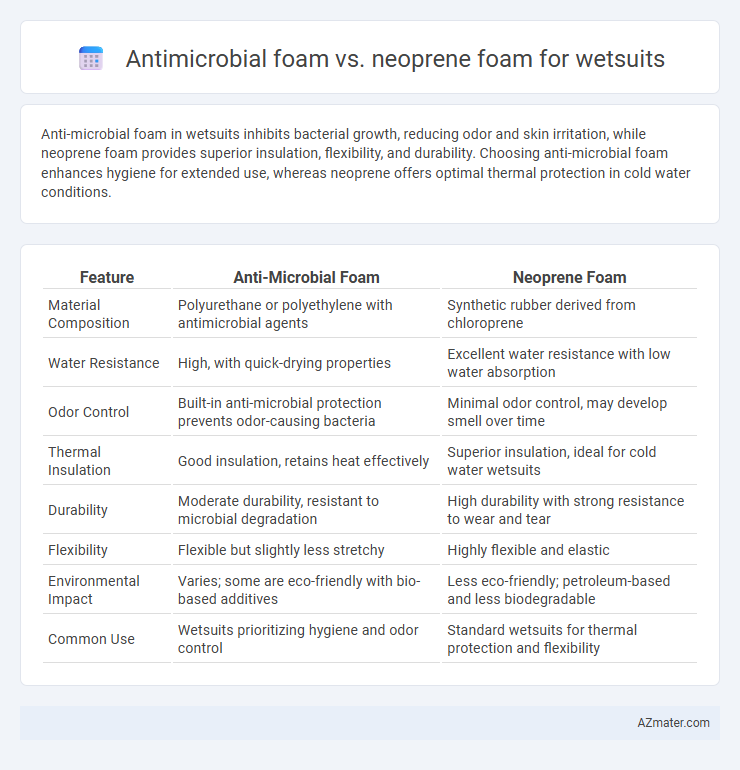Anti-microbial foam in wetsuits inhibits bacterial growth, reducing odor and skin irritation, while neoprene foam provides superior insulation, flexibility, and durability. Choosing anti-microbial foam enhances hygiene for extended use, whereas neoprene offers optimal thermal protection in cold water conditions.
Table of Comparison
| Feature | Anti-Microbial Foam | Neoprene Foam |
|---|---|---|
| Material Composition | Polyurethane or polyethylene with antimicrobial agents | Synthetic rubber derived from chloroprene |
| Water Resistance | High, with quick-drying properties | Excellent water resistance with low water absorption |
| Odor Control | Built-in anti-microbial protection prevents odor-causing bacteria | Minimal odor control, may develop smell over time |
| Thermal Insulation | Good insulation, retains heat effectively | Superior insulation, ideal for cold water wetsuits |
| Durability | Moderate durability, resistant to microbial degradation | High durability with strong resistance to wear and tear |
| Flexibility | Flexible but slightly less stretchy | Highly flexible and elastic |
| Environmental Impact | Varies; some are eco-friendly with bio-based additives | Less eco-friendly; petroleum-based and less biodegradable |
| Common Use | Wetsuits prioritizing hygiene and odor control | Standard wetsuits for thermal protection and flexibility |
Introduction to Wet Suit Materials
Wet suit materials typically include anti-microbial foam and neoprene foam, each offering unique properties for water sports. Anti-microbial foam enhances hygiene by inhibiting bacterial growth, reducing odors and skin irritations during prolonged use. Neoprene foam remains the industry standard due to its excellent insulation, flexibility, and durability in cold water conditions.
What is Neoprene Foam?
Neoprene foam is a synthetic rubber material known for its excellent insulation, flexibility, and water resistance, making it the primary choice for wetsuit construction. Anti-microbial foam incorporates additives that inhibit the growth of bacteria and fungi, reducing odor and enhancing hygiene, but its base material is often still neoprene. Comparing the two, neoprene foam offers superior thermal protection, while anti-microbial foam targets long-term cleanliness and wearer comfort.
What is Anti-microbial Foam?
Anti-microbial foam in wetsuits incorporates agents that inhibit bacteria, mold, and mildew growth, enhancing hygiene and reducing odor over time. This foam offers durable protection by preventing microbial degradation, which extends wetsuit lifespan compared to traditional materials. Neoprene foam, while providing flexibility and insulation, lacks inherent anti-microbial properties and is more prone to odor and material breakdown in moist environments.
Key Differences in Material Composition
Anti-microbial foam in wetsuits incorporates silver ions or other biocidal agents within its cellular structure to inhibit the growth of bacteria, fungi, and odor-causing microbes, enhancing hygiene and durability. Neoprene foam, primarily made from synthetic rubber derived from chloroprene, provides excellent insulation and flexibility but lacks inherent anti-microbial properties, requiring additional treatments to prevent microbial growth. The key difference lies in the embedded antimicrobial agents within the foam matrix of anti-microbial foam versus the pure elastomeric composition of neoprene foam used mainly for thermal performance.
Comfort and Flexibility Comparison
Anti-microbial foam in wetsuits offers enhanced comfort by reducing odor-causing bacteria and maintaining a fresher interior environment, which is crucial for prolonged wear. Neoprene foam provides superior flexibility due to its closed-cell structure, allowing better stretch and movement, essential for activities requiring a full range of motion. Comparing the two, anti-microbial foam excels in hygiene and comfort, while neoprene foam leads in flexibility and durability for active water sports.
Durability and Longevity
Anti-microbial foam in wetsuits offers enhanced resistance to bacteria and odor buildup, extending the suit's freshness over time, but may have moderate durability compared to neoprene. Neoprene foam is renowned for its superior durability and flexibility, maintaining structural integrity and insulation properties even after prolonged use in harsh conditions. For long-term performance, neoprene foam generally provides greater longevity, while anti-microbial foam adds value through hygiene and reduced microbial degradation.
Resistance to Odors and Bacterial Growth
Anti-microbial foam in wetsuits significantly reduces odor and bacterial growth due to embedded silver ions or other antimicrobial agents that inhibit microbial proliferation. Neoprene foam lacks inherent antimicrobial properties, making it more prone to retaining odors and supporting bacterial colonies after repeated exposure to moisture. Choosing anti-microbial foam enhances long-term freshness and hygiene, especially in humid and water-based conditions.
Environmental Impact and Sustainability
Anti-microbial foam used in wetsuits often incorporates synthetic additives to inhibit bacterial growth, which can introduce non-biodegradable chemicals into marine environments, raising concerns about long-term ecological impact. Neoprene foam, traditionally derived from petroleum-based sources, has significant carbon footprints and is less sustainable due to its non-biodegradability and energy-intensive production processes. Recent advances in plant-based neoprene alternatives and recycled materials aim to reduce environmental impact and improve the sustainability profile of wetsuit foams.
Cost and Availability
Anti-microbial foam for wetsuits typically costs more due to its specialized treatment that inhibits bacteria growth, ensuring longer hygiene and odor control. Neoprene foam remains widely available and more affordable, offering reliable insulation and flexibility without the added antimicrobial benefits. Both materials are accessible in most markets, but budget-conscious consumers often prefer neoprene for its cost-effectiveness and local availability.
Which Foam is Best for Your Needs?
Anti-microbial foam offers superior resistance to bacteria and odor, making it ideal for wetsuits used in warm or frequently wet conditions where hygiene is a priority. Neoprene foam excels in insulation and flexibility, providing excellent thermal protection and comfort for colder waters and extended wear. Choosing the best foam depends on whether odor control or thermal performance aligns more closely with your specific wetsuit requirements.

Infographic: Anti-microbial foam vs Neoprene foam for Wet suit
 azmater.com
azmater.com